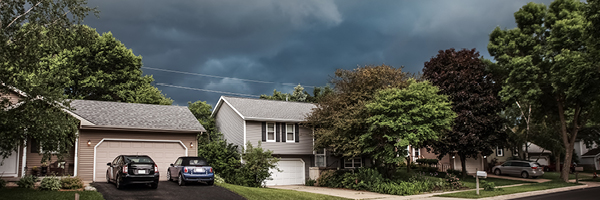
When a storm is on the way, every minute matters as you take steps to protect yourself and your property. Follow these seven simple, last-minute tips to learn how to prepare for a thunderstorm including high winds, hail, heavy rain and other severe weather.
1. Designate a safe room
One of the most important steps you can take while preparing for a storm is to find a suitable place to take cover when the storm rolls through your neighborhood. The Insurance Institute for Business and Home Safety (IBHS) recommends choosing a room without windows on the lowest level of your home. Basements and storm cellars are great options for a safe shelter.
If you don’t have a lower level, choose a closet, bathroom or room as close to the center of your home as possible. The key is to choose a room without windows because damaging wind can carry anything from debris to flying tree branches through your windows and into your home.
IBHS also recommends crouching under a sturdy piece of furniture like a table and using your arms to protect your neck and head. The National Weather Service offers similar guidelines: get in, get down and cover up.
2. Get organized
During last-minute storm prep, you may not have the time to get very organized. But if you have a few minutes to spare, you can take simple steps like organizing your garage to fit your vehicle or clearing out an interior room to barricade safely during the storm. IBHS says parking in a garage is a great way to protect your car from large hail and flying debris. Consider keeping space available for parking your vehicle(s) in your garage all year round for one less storm prep task to worry about.
Inside your home, remove fragile pieces like glass, lamps or ceramics from the room where you’re taking cover. These decorations can shatter and cause injury during the storm. Finally, locate or store your emergency supplies kit and first aid kit inside your safe room.
3. Close and reinforce your garage door
Remember your garage door in the hours leading up to a severe storm. To prepare your garage door for high winds and possible severe weather conditions, IBHS recommends closing the door and reinforcing it with a brace. A brace will help keep your door intact and reduce the chances of wind blowing it in.

Learn about our
Home Insurance
4. Collect and store yard items
Patio furniture, toys, grills, hammocks, potted plants and other outdoor items can cause serious damage to your home if they are swept up in a storm. If you have time before the storm, stow them in a safe sheltered area like a garage, shed or storage unit. Bring them inside the house as a last resort.
Storm tip: Assign a yard item to everyone in your household to collect everything in a quick manner. Then head to your safe room as a group and take cover.
5. Stay informed
Have a plan intact for staying connected and getting information from weather experts before, during and after the storm. However, electronics that are plugged into an outlet can become unsafe to use during a hailstorm or other severe weather. Consider investing in a weather alert radio with a hand crank to power devices and tune into radio stations.
Beyond following radio alerts, IBHS recommends following NOAA’s Storm Prediction Center (SPC) on social media and enabling wireless emergency alerts on your cell phone. The National Weather Service also broadcasts emergency alerts that you can pick up on your weather alert radio without electricity or cell service.
6. Anticipate power outages
Don’t forget to charge your devices so that you can communicate with loved ones, utility companies and local authorities in case of an emergency. Additionally, turn on low battery settings and store your device in a safe place during the storm.
Consider downloading movies and games in advance to keep children occupied if you lose power or cell service. A rechargeable battery pack is a great tool for keeping devices powered for days at a time during a power outage.
7. Learn storm language
Do you know the difference between a Severe Thunderstorm Warning and a Severe Thunderstorm Watch? According to the National Weather Service, a Severe Thunderstorm Watch means thunderstorms are possible in and around the viewing area, so it’s time to prepare for the storm. A Severe Thunderstorm Warning means it’s time to seek shelter because severe weather has been reported in the area. During a Severe Thunderstorm Warning, it’s no longer safe to be outside and you should take shelter in your safe room as quickly as possible.
Get familiar with the most common storm terms to make severe weather easier to navigate.
References
Insurance Institute for Business & Home Safety (IBHS)
National Weather Service
Consumer Reports
Weather.gov Safety
Coverages described herein may not be available in all states. Please contact a local independent Grange agent for complete details on coverages and discounts. If the policy coverage descriptions herein conflict with the language in the policy, the language in the policy applies. The material provided above is for informational, educational, or suggestion purposes and does not imply coverage. WE RESERVE THE RIGHT TO REFUSE TO QUOTE ANY INDIVIDUAL PREMIUM RATE FOR THE INSURANCE HEREIN ADVERTISED. Grange Insurance policies are underwritten by Grange Insurance Company, Trustgard Insurance Company, Grange Indemnity Insurance Company, Grange Insurance Company of Michigan and Grange Property & Casualty Insurance Company*. Not all companies are licensed in all states. *Not licensed in Pennsylvania.